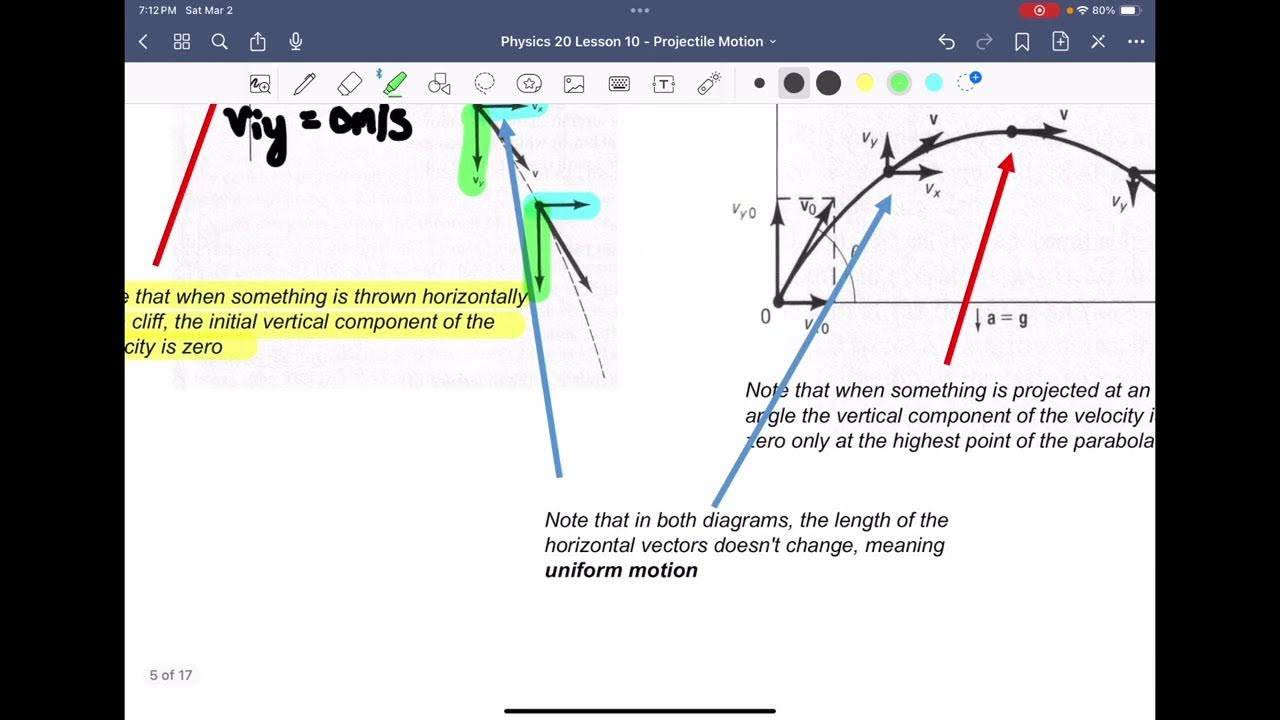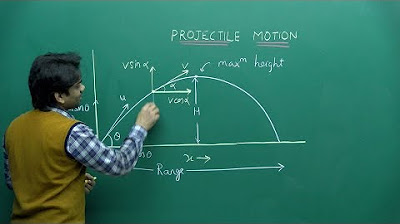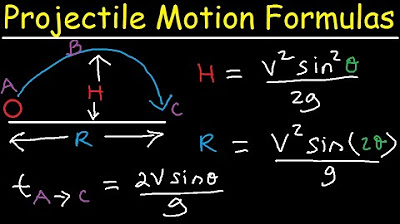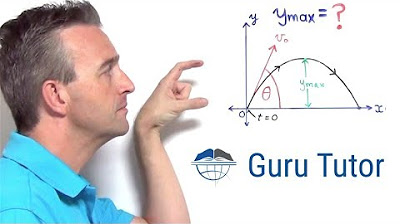Deriving the 6 Basic Projectile Motion Equations
TLDRThis video script delves into the fundamentals of projectile motion, outlining six key equations derived from constant acceleration principles, specifically the SUVAT equations, without the use of calculus. It explains the concept of a projectile, its initial velocity, and projection angle, and how these factors contribute to the trajectory. The script then methodically breaks down the motion into horizontal and vertical components, detailing how to calculate the acceleration, velocity, and displacement in both directions, and addresses the impact of gravity on the vertical motion. The inclusion of trigonometric relationships and the consideration of initial conditions, such as height from a cliff, add depth to the understanding of projectile motion. The video encourages viewers to practice deriving these equations independently for a comprehensive grasp of the subject.
Takeaways
- 📐 Projectile motion involves an object moving under the influence of gravity alone.
- 🚀 The path of a projectile is called the trajectory, and it is influenced by its initial velocity and projection angle.
- 🎯 The motion of a projectile can be split into horizontal and vertical components for analysis.
- 🔄 Horizontal motion has zero acceleration due to the absence of horizontal forces (assuming no air resistance).
- 🌟 The initial velocity (V naught) and projection angle (theta) are constant for a projectile.
- 📈 The horizontal component of the initial velocity is given by V naught times the cosine of the projection angle (V naught cos theta).
- 🏋️♂️ The vertical acceleration of a projectile is equal to the acceleration due to gravity (g), which is -9.81 m/s² downwards.
- 📊 The vertical component of the initial velocity is given by V naught times the sine of the projection angle (V naught sin theta).
- 🛤️ The horizontal displacement of a projectile is calculated using the formula: X = V naught * T * cos(theta).
- 🏞️ The vertical displacement of a projectile is calculated using the formula: Y = V naught * T * sin(theta) - 0.5 * g * T².
- 📚 Understanding and being able to derive the six basic motion equations for projectile motion is crucial for solving related physics problems.
Q & A
What are the six basic motion equations mentioned in the transcript?
-The six basic motion equations mentioned are derived from the constant acceleration equations, also known as the SUVAT equations, used in physics for analyzing projectile motion without the use of calculus.
What is a projectile in the context of the transcript?
-A projectile, as described in the transcript, is an object that is flying through the air solely under the influence of gravity.
What is the significance of the projection angle (theta) in projectile motion?
-The projection angle (theta) is significant as it defines the initial direction in which the projectile is launched. It remains constant throughout the motion of the projectile in the air.
How does air resistance affect projectile motion?
-The transcript assumes no air resistance, meaning that the only force acting on the projectile is gravity. In reality, air resistance can affect the motion by reducing the object's speed and altering its trajectory.
What is the horizontal acceleration of a projectile in the absence of air resistance?
-In the absence of air resistance, the horizontal acceleration of a projectile is zero because there are no horizontal forces acting on the projectile.
How is the initial velocity (V naught) related to its horizontal (V naught X) and vertical (V naught Y) components?
-The initial velocity (V naught) can be split into its horizontal (V naught X) and vertical (V naught Y) components using trigonometric functions. V naught X is equal to V naught times the cosine of the projection angle (theta), and V naught Y is equal to V naught times the sine of the projection angle (theta).
What is the equation for horizontal displacement in projectile motion?
-The equation for horizontal displacement (X) in projectile motion is given by X = V naught X * T, where V naught X is the horizontal component of the initial velocity and T is the time.
What is the acceleration acting on a projectile in the vertical direction?
-The acceleration acting on a projectile in the vertical direction is the acceleration due to gravity (g), which is approximately 9.81 m/s^2 and is considered negative in the equations because it acts downward.
How can the equations for projectile motion be adjusted for a projectile launched from a height?
-For a projectile launched from a height (H), the vertical displacement equation (y) should include an additional term of +h, representing the initial height from which the projectile is launched.
Why is it important to be able to derive the six motion equations on your own?
-Being able to derive the six motion equations on your own enhances understanding and retention of the concepts. It is a valuable exercise that helps in applying these equations to solve problems related to projectile motion.
What is the final equation for vertical displacement in projectile motion?
-The final equation for vertical displacement (y) in projectile motion is given by y = V naught Y * T - (1/2) * g * T^2, where V naught Y is the vertical component of the initial velocity and g is the acceleration due to gravity.
Outlines
🚀 Introduction to Projectile Motion
This paragraph introduces the concept of projectile motion, explaining it as the movement of an object through the air solely under the influence of gravity. It emphasizes the absence of air resistance and the importance of understanding the constant acceleration equations from physics, specifically the SUVAT equations, before proceeding. The paragraph sets the stage for the detailed explanation of projectile motion by describing a projectile's trajectory and its initial velocity and angle.
🌐 Horizontal Motion Analysis
This section delves into the analysis of horizontal motion in projectile motion. It explains that the horizontal acceleration is zero due to the absence of horizontal forces, and it uses one of the SUVAT equations to derive the horizontal component of velocity. The paragraph also discusses the initial value of velocity and breaks it down into horizontal and vertical components using trigonometric functions. The derivation leads to the first three equations of projectile motion that pertain to horizontal motion.
📉 Vertical Motion and Equations
This paragraph focuses on the vertical aspect of projectile motion, highlighting that the only acceleration acting on the projectile is the acceleration due to gravity, which is negative in the chosen coordinate system. It provides the first equation for vertical motion, emphasizing that the gravitational constant (G) should always be positive. The paragraph then uses another SUVAT equation to derive the vertical component of velocity and displacement, leading to the last three equations of projectile motion. It also addresses the scenario where the projectile is launched from a height, adjusting the equations accordingly.
Mindmap
Keywords
💡Projectile Motion
💡Constant Acceleration (SUVAT Equations)
💡Initial Velocity (V_nought)
💡Projection Angle (Theta)
💡Line of Trajectory
💡Horizontal and Vertical Components
💡Acceleration Due to Gravity (g)
💡Trigonometry (Cosine and Sine)
💡Displacement
💡Cliff Problem
💡Derivation
Highlights
Projectile motion is described by six basic motion equations derived from constant acceleration principles, also known as SUVAT equations.
In projectile motion, an object flies through the air solely under the influence of gravity, tracing out a path called the trajectory.
The initial velocity (V naught) and projection angle (theta) of a projectile are constants that do not change throughout its flight.
The motion of a projectile is split into horizontal and vertical components for analysis, using two-dimensional kinematic equations.
Horizontal acceleration of a projectile is zero, assuming no air resistance, as there are no horizontal forces acting on the object.
The horizontal component of the initial velocity (V naught X) can be found using trigonometry, specifically V naught X = V naught * cos(theta).
The horizontal displacement (X) of a projectile can be calculated using the formula X = V naught * T * cos(theta), where T is the time of flight.
The acceleration of a projectile in the vertical direction is equal to the acceleration due to gravity (g), which is -9.81 m/s^2, directed downwards.
The vertical component of the initial velocity (V naught Y) is determined by V naught Y = V naught * sin(theta), using the initial angle of projection.
The vertical displacement (Y) of a projectile is given by Y = V naught * T * sin(theta) - 0.5 * g * T^2, incorporating both initial conditions and gravitational acceleration.
Projectile motion equations can be applied to scenarios such as a projectile launched from a cliff, with adjustments to account for the initial height (H).
Understanding and being able to derive the six motion equations for projectile motion is emphasized as an essential skill, with practical applications in various fields.
The presentation of projectile motion principles avoids the use of calculus, making it accessible to a broader audience through basic physics concepts.
The importance of practice in deriving these equations independently is highlighted, as it deepens understanding and retention of the concepts.
The transcript provides a structured approach to learning projectile motion, breaking down complex ideas into manageable parts for easier comprehension.
Trigonometric functions, such as cosine and sine, play a crucial role in calculating the horizontal and vertical components of the initial velocity in projectile motion.
The concept of constant acceleration is fundamental to the analysis of projectile motion, with the acceleration due to gravity being a key factor in the vertical motion.
The transcript emphasizes the importance of correctly applying the sign convention when dealing with the acceleration due to gravity in vertical motion analysis.
The final set of projectile motion equations provided in the transcript serves as a comprehensive guide for analyzing and solving related physics problems.
Transcripts
Browse More Related Video

Physics 20 Unit A Lesson 10: Projectile Motion

NEET Physics | Projectile Motion | Theory & Problem-Solving | In English | Misostudy

AP Physics 1 Workbook 1.N Projectile Motion Part 2 Solution

Introduction to Projectile Motion - Formulas and Equations

Projectile Motion Maximum Height Formula Derivation

Trajectory of a projectile without drag
5.0 / 5 (0 votes)
Thanks for rating: